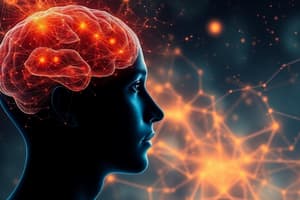Podcast
Questions and Answers
What is the primary mechanism by which the brain registers certain information and rejects other information?
What is the primary mechanism by which the brain registers certain information and rejects other information?
- Bottleneck processing
- Divided attention
- Capacity attention
- Selective attention (correct)
What is the term for the phenomenon where we can focus on one conversation among many people talking at the same time?
What is the term for the phenomenon where we can focus on one conversation among many people talking at the same time?
- Dichotic listening
- Shadowing
- Cocktail party phenomenon (correct)
- Dual-task technique
According to Cherry's dichotic listening research, what makes it more difficult to separate two messages?
According to Cherry's dichotic listening research, what makes it more difficult to separate two messages?
- Same voice for both messages (correct)
- Different genders for the speakers
- Similarity in voice location
- Physical differences in voice intensity
What is the primary goal of the dual-task technique in studying attention?
What is the primary goal of the dual-task technique in studying attention?
What is the result of bottleneck processing in attention?
What is the result of bottleneck processing in attention?
How much of the unattended information do we typically remember?
How much of the unattended information do we typically remember?
What is the primary goal of selective attention?
What is the primary goal of selective attention?
According to William James, what is the essence of attention?
According to William James, what is the essence of attention?
What is the primary difference between active and passive attention?
What is the primary difference between active and passive attention?
In a visual search task, what type of attentional process involves an individual's goals or expectations?
In a visual search task, what type of attentional process involves an individual's goals or expectations?
What is the opposite of attention, according to William James?
What is the opposite of attention, according to William James?
What is the role of attention in visual perception?
What is the role of attention in visual perception?
What is the primary function of Broadbent's selection filter?
What is the primary function of Broadbent's selection filter?
According to Treisman's attenuation theory, what happens to non-shadowed messages?
According to Treisman's attenuation theory, what happens to non-shadowed messages?
What is the main difference between the Deutsch-Norman late-selection filter model and Broadbent's filter model?
What is the main difference between the Deutsch-Norman late-selection filter model and Broadbent's filter model?
What is the main idea behind Driver's concept of focused visual attention?
What is the main idea behind Driver's concept of focused visual attention?
What is the main contribution of single-channel theories to our understanding of attention?
What is the main contribution of single-channel theories to our understanding of attention?
What is the primary difference between the Deutsch-Norman model and other single-channel theories?
What is the primary difference between the Deutsch-Norman model and other single-channel theories?
What is the main difference between controlled processing and automatic processing?
What is the main difference between controlled processing and automatic processing?
Which task competes for the same modules in Schneider and Shiffrin's model?
Which task competes for the same modules in Schneider and Shiffrin's model?
What is the 'Cocktail Party Effect'?
What is the 'Cocktail Party Effect'?
Which of the following is NOT a characteristic of automatic processing?
Which of the following is NOT a characteristic of automatic processing?
What is the primary difference between similar tasks and dissimilar tasks?
What is the primary difference between similar tasks and dissimilar tasks?
What is attention, in the context of psychology?
What is attention, in the context of psychology?
What is the primary function of mechanisms of attention in the context of vision?
What is the primary function of mechanisms of attention in the context of vision?
According to Feature Integration Theory, what happens to perceptual features of objects prior to attention?
According to Feature Integration Theory, what happens to perceptual features of objects prior to attention?
What is the term for the involuntary attentional capture of our response, beyond our control?
What is the term for the involuntary attentional capture of our response, beyond our control?
What type of visual search task requires attention to a specific feature of the target, making it more difficult?
What type of visual search task requires attention to a specific feature of the target, making it more difficult?
What is the disorder characterized by a lack of attention to one side of the visual field?
What is the disorder characterized by a lack of attention to one side of the visual field?
What is the phenomenon where we cannot help but respond to a particular stimulus, despite our efforts to focus on something else?
What is the phenomenon where we cannot help but respond to a particular stimulus, despite our efforts to focus on something else?
Flashcards are hidden until you start studying
Study Notes
Attention Overview
- Attention is the process of selecting and focusing on specific information or stimuli while ignoring others.
- It involves mechanisms that register certain information and reject others, whether or not the rejected information enters conscious awareness.
Selective Attention
- Refers to the ability to focus on one stimulus or message while ignoring others.
- Cherry's dichotic listening and shadowing research (1953) demonstrated that people can focus on one conversation while ignoring others.
- Physical differences such as voice intensity, location, and gender affect selective attention.
- Even when we're not attending to certain information, very little of it is remembered.
Divided Attention
- Refers to the ability to process multiple stimuli or messages simultaneously.
- The dual-task technique is used to study divided attention.
Theories of Selective Attention
- Broadbent's filter model (1958): information is filtered early in the processing stream, and only attended information is processed further.
- Treisman's attenuation model (1964): unattended information is not rejected, but its "volume" is reduced, allowing it to still be processed.
- Deutsch and Deutsch's late-selection filter model (1963): all information is processed, and selection occurs later in the processing stream.
Focused Visual Attention
- Driver (1996): visual attention is similar to auditory attention, but with more opportunities for attending to multiple stimuli.
- Automatic processing: no demands on attentional resources, and unconscious awareness.
- Controlled processing: demands on attentional resources, and conscious awareness.
- Schneider and Shiffrin's automaticity model (1977): tasks can be automatic or controlled, depending on attentional resources.
Visual Search
- Neisser (1967): visual search involves processing simultaneous items, but not fully being aware of them.
- Treisman (1998): focus on stimulus first, and then feature synthesis into a pattern.
- Feature integration theory (Treisman, 1988, 1992): features of objects are separable from the object itself, and are encoded in parallel and prior to attention.
- Visual search tasks: feature search (target has a unique feature) and conjunctive search (target has no unique feature).
Attention Switching
- Visual neglect disorder (Ramachandran; Rogers-Ramachandran, 2009): a disorder of attention where attention is involuntarily captured.
- Involuntary attentional capture: response beyond our control.
- Voluntary attentional vigilance: focus on some particular aspect.
Studying That Suits You
Use AI to generate personalized quizzes and flashcards to suit your learning preferences.




